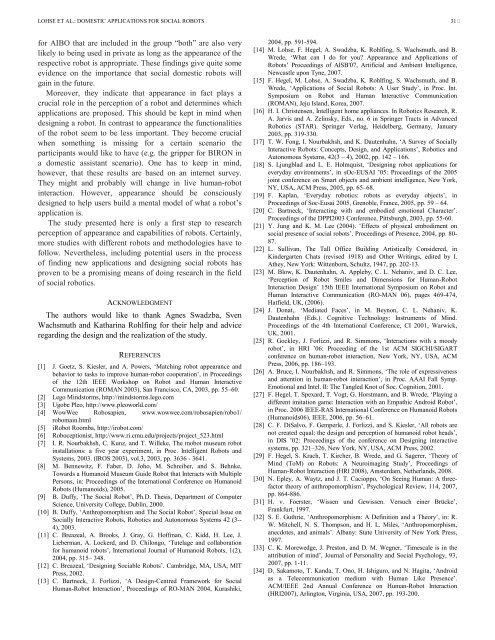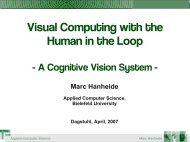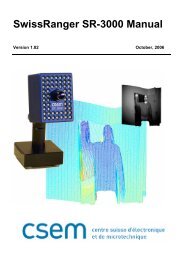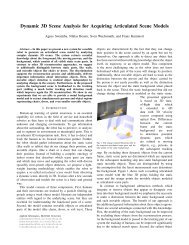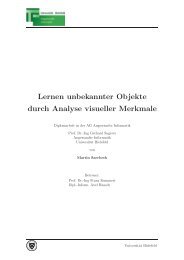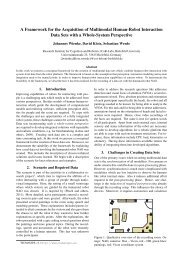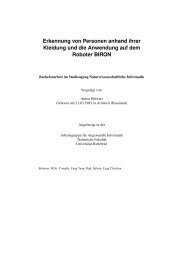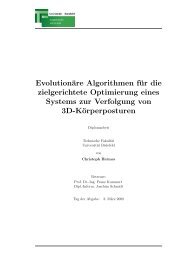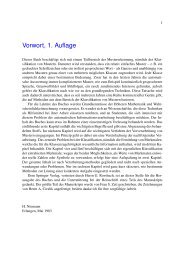Domestic Applications for Social Robots - Journal of Physical Agents
Domestic Applications for Social Robots - Journal of Physical Agents
Domestic Applications for Social Robots - Journal of Physical Agents
You also want an ePaper? Increase the reach of your titles
YUMPU automatically turns print PDFs into web optimized ePapers that Google loves.
LOHSE ET AL.: DOMESTIC APPLICATIONS FOR SOCIAL ROBOTS 31<br />
<strong>for</strong> AIBO that are included in the group “both” are also very<br />
likely to being used in private as long as the appearance <strong>of</strong> the<br />
respective robot is appropriate. These findings give quite some<br />
evidence on the importance that social domestic robots will<br />
gain in the future.<br />
Moreover, they indicate that appearance in fact plays a<br />
crucial role in the perception <strong>of</strong> a robot and determines which<br />
applications are proposed. This should be kept in mind when<br />
designing a robot. In contrast to appearance the functionalities<br />
<strong>of</strong> the robot seem to be less important. They become crucial<br />
when something is missing <strong>for</strong> a certain scenario the<br />
participants would like to have (e.g. the gripper <strong>for</strong> BIRON in<br />
a domestic assistant scenario). One has to keep in mind,<br />
however, that these results are based on an internet survey.<br />
They might and probably will change in live human-robot<br />
interaction. However, appearance should be consciously<br />
designed to help users build a mental model <strong>of</strong> what a robot’s<br />
application is.<br />
The study presented here is only a first step to research<br />
perception <strong>of</strong> appearance and capabilities <strong>of</strong> robots. Certainly,<br />
more studies with different robots and methodologies have to<br />
follow. Nevertheless, including potential users in the process<br />
<strong>of</strong> finding new applications and designing social robots has<br />
proven to be a promising means <strong>of</strong> doing research in the field<br />
<strong>of</strong> social robotics.<br />
ACKNOWLEDGMENT<br />
The authors would like to thank Agnes Swadzba, Sven<br />
Wachsmuth and Katharina Rohlfing <strong>for</strong> their help and advice<br />
regarding the design and the realization <strong>of</strong> the study.<br />
REFERENCES<br />
[1] J. Goetz, S. Kiesler, and A. Powers, ‘Matching robot appearance and<br />
behavior to tasks to improve human-robot cooperation’, in Proceedings<br />
<strong>of</strong> the 12th IEEE Workshop on Robot and Human Interactive<br />
Communication (ROMAN 2003), San Francisco, CA, 2003, pp. 55–60.<br />
[2] Lego Mindstorms, http://mindstorms.lego.com<br />
[3] Ugobe Pleo, http://www.pleoworld.com/<br />
[4] WowWee Robosapien, www.wowwee.com/robosapien/robo1/<br />
robomain.html<br />
[5] iRobot Roomba, http://irobot.com/<br />
[6] Roboceptionist, http://www.ri.cmu.edu/projects/project_523.html<br />
[7] I. R. Nourbakhsh, C. Kunz, and T. Willeke, The mobot museum robot<br />
installations: a five year experiment, in Proc. Intelligent <strong>Robots</strong> and<br />
Systems, 2003. (IROS 2003), vol.3, 2003, pp. 3636 - 3641.<br />
[8] M. Bennewitz, F. Faber, D. Joho, M. Schreiber, and S. Behnke,<br />
Towards a Humanoid Museum Guide Robot that Interacts with Multiple<br />
Persons, in: Proceedings <strong>of</strong> the International Conference on Humanoid<br />
<strong>Robots</strong> (Humanoids), 2005.<br />
[9] B. Duffy, ‘The <strong>Social</strong> Robot’, Ph.D. Thesis, Department <strong>of</strong> Computer<br />
Science, University College, Dublin, 2000.<br />
[10] B. Duffy, ‘Anthropomorphism and The <strong>Social</strong> Robot’, Special Issue on<br />
<strong>Social</strong>ly Interactive <strong>Robots</strong>, Robotics and Autonomous Systems 42 (3--<br />
4), 2003.<br />
[11] C. Breazeal, A. Brooks, J. Gray, G. H<strong>of</strong>fman, C. Kidd, H. Lee, J.<br />
Lieberman, A. Lockerd, and D. Chilongo, ‘Tutelage and collaboration<br />
<strong>for</strong> humanoid robots’, International <strong>Journal</strong> <strong>of</strong> Humanoid <strong>Robots</strong>, 1(2),<br />
2004, pp. 315– 348.<br />
[12] C. Breazeal, ‘Designing Sociable <strong>Robots</strong>’. Cambridge, MA, USA, MIT<br />
Press, 2002.<br />
[13] C. Bartneck, J. Forlizzi, ‘A Design-Centred Framework <strong>for</strong> <strong>Social</strong><br />
Human-Robot Interaction’, Proceedings <strong>of</strong> RO-MAN 2004, Kurashiki,<br />
2004, pp. 591-594.<br />
[14] M. Lohse, F. Hegel, A. Swadzba, K. Rohlfing, S. Wachsmuth, and B.<br />
Wrede, ‘What can I do <strong>for</strong> you? Appearance and <strong>Applications</strong> <strong>of</strong><br />
<strong>Robots</strong>’ Proceedings <strong>of</strong> AISB'07, Artificial and Ambient Intelligence,<br />
Newcastle upon Tyne, 2007.<br />
[15] F. Hegel, M. Lohse, A. Swadzba, K. Rohlfing, S. Wachsmuth, and B.<br />
Wrede, ‘<strong>Applications</strong> <strong>of</strong> <strong>Social</strong> <strong>Robots</strong>: A User Study’, in Proc. Int.<br />
Symposium on Robot and Human Interactive Communication<br />
(ROMAN), Jeju Island, Korea, 2007.<br />
[16] H. I. Christensen, Intelligent home appliances. In Robotics Research, R.<br />
A. Jarvis and A. Zelinsky, Eds., no. 6 in Springer Tracts in Advanced<br />
Robotics (STAR). Springer Verlag, Heidelberg, Germany, January<br />
2003, pp. 319-330.<br />
[17] T. W. Fong, I. Nourbakhsh, and K. Dautenhahn, ‘A Survey <strong>of</strong> <strong>Social</strong>ly<br />
Interactive <strong>Robots</strong>: Concepts, Design, and <strong>Applications</strong>’, Robotics and<br />
Autonomous Systems, 42(3 – 4), 2002, pp. 142 – 166.<br />
[18] S. Ljungblad and L. E. Holmquist, ‘Designing robot applications <strong>for</strong><br />
everyday environments’, in sOc-EUSAI ’05: Proceedings <strong>of</strong> the 2005<br />
joint conference on Smart objects and ambient intelligence, New York,<br />
NY, USA, ACM Press, 2005, pp. 65–68.<br />
[19] F. Kaplan, ‘Everyday robotics: robots as everyday objects’, in<br />
Proceedings <strong>of</strong> Soc-Eusai 2005, Grenoble, France, 2005, pp. 59 – 64.<br />
[20] C. Bartneck, ‘Interacting with and embodied emotional Character’.<br />
Proceedings <strong>of</strong> the DPPI2003 Conference, Pittsburgh, 2003, pp. 55-60.<br />
[21] Y. Jung and K. M. Lee (2004). ‘Effects <strong>of</strong> physical embodiment on<br />
social presence <strong>of</strong> social robots’. Proceedings <strong>of</strong> Presence, 2004, pp. 80-<br />
87.<br />
[22] L. Sullivan, The Tall Office Building Artistically Considered, in<br />
Kindergarten Chats (revised 1918) and Other Writings, edited by I.<br />
Athey, New York: Wittenborn, Schultz, 1947, pp. 202-13.<br />
[23] M. Blow, K. Dautenhahn, A. Appleby, C. L. Nehaniv, and D. C. Lee,<br />
‘Perception <strong>of</strong> Robot Smiles and Dimensions <strong>for</strong> Human-Robot<br />
Interaction Design’ 15th IEEE International Symposium on Robot and<br />
Human Interactive Communication (RO-MAN 06), pages 469-474,<br />
Hatfield, UK, (2006).<br />
[24] J. Donat,. ‘Mediated Faces’, in M. Beynon, C. L. Nehaniv, K.<br />
Dautenhahn (Eds.). Cognitive Technology: Instruments <strong>of</strong> Mind.<br />
Proceedings <strong>of</strong> the 4th International Conference, CI 2001, Warwick,<br />
UK, 2001.<br />
[25] R. Gockley, J. Forlizzi, and R. Simmons, ‘Interactions with a moody<br />
robot’, in HRI ’06: Proceeding <strong>of</strong> the 1st ACM SIGCHI/SIGART<br />
conference on human-robot interaction, New York, NY, USA, ACM<br />
Press, 2006, pp. 186–193.<br />
[26] A. Bruce, I. Nourbakhsh, and R. Simmons, ‘The role <strong>of</strong> expressiveness<br />
and attention in human-robot interaction’, in Proc. AAAI Fall Symp.<br />
Emotional and Intel. II: The Tangled Knot <strong>of</strong> Soc. Cognition, 2001.<br />
[27] F. Hegel, T. Spexard, T. Vogt, G. Horstmann, and B. Wrede, ‘Playing a<br />
different imitation game: Interaction with an Empathic Android Robot’,<br />
in Proc. 2006 IEEE-RAS International Conference on Humanoid <strong>Robots</strong><br />
(Humanoids06), IEEE, 2006, pp. 56–61.<br />
[28] C. F. DiSalvo, F. Gemperle, J. Forlizzi, and S. Kiesler, ‘All robots are<br />
not created equal: the design and perception <strong>of</strong> humanoid robot heads’,<br />
in DIS ’02: Proceedings <strong>of</strong> the conference on Designing interactive<br />
systems, pp. 321–326, New York, NY, USA, ACM Press, 2002.<br />
[29] F. Hegel, S. Krach, T. Kircher, B. Wrede, and G. Sagerer, ‘Theory <strong>of</strong><br />
Mind (ToM) on <strong>Robots</strong>: A Neuroimaging Study’, Proceedings <strong>of</strong><br />
Human-Robot Interaction (HRI 2008), Amsterdam, Netherlands, 2008.<br />
[30] N. Epley, A. Waytz, and J. T. Cacioppo, ‘On Seeing Human: A threefactor<br />
theory <strong>of</strong> anthropomorphism’, Psychological Review, 114, 2007,<br />
pp. 864-886.<br />
[31] H. v. Foerster, ‘Wissen und Gewissen. Versuch einer Brücke’,<br />
Frankfurt, 1997.<br />
[32] S. E. Guthrie, ‘Anthropomorphism: A Definition and a Theory’, in: R.<br />
W. Mitchell, N. S. Thompson, and H. L. Miles, ‘Anthropomorphism,<br />
anecdotes, and animals’. Albany: State University <strong>of</strong> New York Press,<br />
1997.<br />
[33] C. K. Morewedge, J. Preston, and D. M. Wegner, ‘Timescale is in the<br />
attribution <strong>of</strong> mind’, <strong>Journal</strong> <strong>of</strong> Personality and <strong>Social</strong> Psychology, 93,<br />
2007, pp. 1-11.<br />
[34] D. Sakamoto, T. Kanda, T. Ono, H. Ishiguro, and N. Hagita, ‘Android<br />
as a Telecommunication medium with Human Like Presence’.<br />
ACM/IEEE 2nd Annual Conference on Human-Robot Interaction<br />
(HRI2007), Arlington, Virginia, USA, 2007, pp. 193-200.


